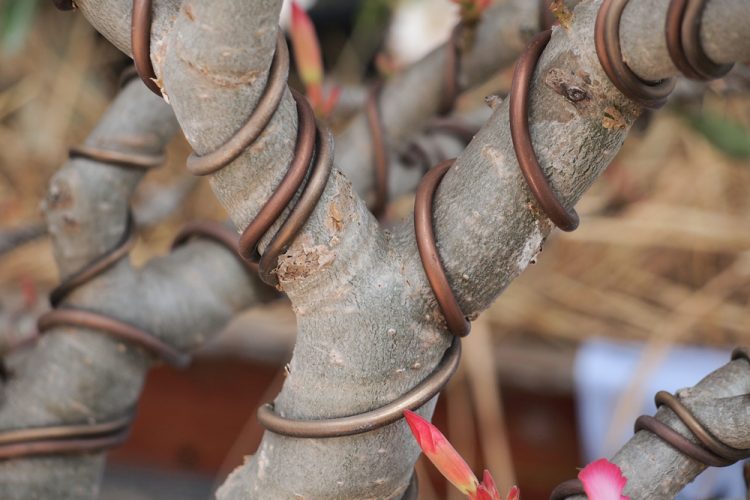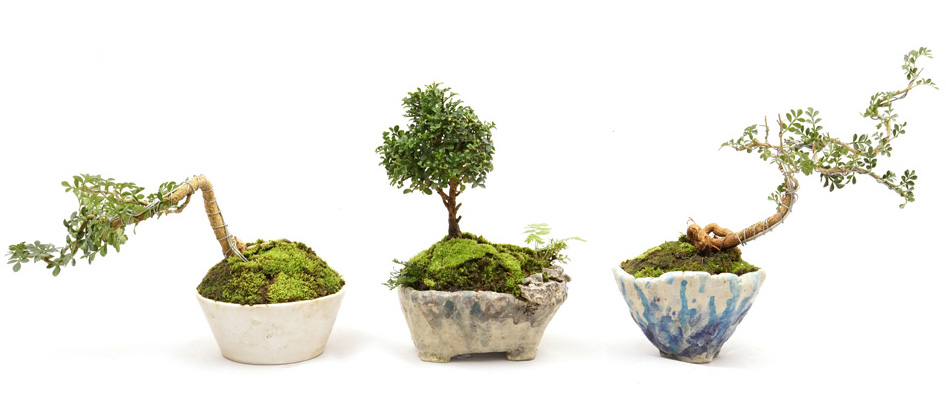Wiring a Bonsai Tree
A very crucial process that helps style your bonsai is wiring–every properly designed bonsai tree has been wired during its development. It can seem like it is a completely baffling technique to duplicate, but it will allow you to be able to manipulate and control the branches of the bonsai far better.

The trunk or branch will hold the position it has placed in (after a few weeks or months) when you remove the wire. You can wire young branches into a downward or horizontal pose to conjure the illusion that your tree is far more mature than it is. You can shift the branches and foliage to areas that seem bare in an effort to fully shape the tree’s silhouette.
If you do not use the wiring technique then you cannot control the direction shoots and branches grow in and you may not be able to achieve your desired effect. By using wiring you can easily manipulate existing growth to form the shape you want. Look at your tree and figure out what shape best suits it and then wire your bonsai accordingly. Study the shape of your tree very carefully and pay attention to its natural inherent form before you decide what shape your bonsai should take. Look at mature trees (of the same type) and the way they grow in nature–think about how your little bonsai can give the impressions of age and be realistic at the same time.
Before you start, you will have to decide what the final size and shape of your bonsai will be.To do this, you can create a rough sketch of what you want the finished product to be to use as a guide. For beginners, it is recommended that they use aluminum wire. Copper wire is far more difficult to handle and maneuver even though, when compared to aluminum, it has better holding power.

A good rule of thumb is to use a wire that has a gauge (thickness) of about 1/3 of the branch or trunk that you wish to move or bend. Be sure that the wire you use is thick enough to not only bend the branch but also is able to remain and hold its position, and the wire has to be thin enough so that you can easily move and manipulate it. Before you apply wire to the plant you will not want to water it for a day to ensure that it is flexible. When you are ready to wire you will always want to start at the bottom of the plant and work your way up. To anchor the end of your wire at the bottom of the tree just push the end into the soil. To protect the branches and ensure that the wire does not cut in or scar them, apply foam pads between the wire and branch.
The wiring of branches and the bending of them can cause small splits and minute fractures underneath the branches’ bark; once the cambium layers have healed and repaired the damage then you can remove the wire because the position has been set. Therefore, the quicker a branch grows then the faster it can heal and the earlier you can take the wire off without fearing it will return to its former position.
When it is possible you should always apply the wire at a 45deg angle towards the branch that you are wiring. Hold the end point with your left hand (firmly) and wind the wire along down the branch, when you do so you can shift the position where your hand is securing the end point. You should not be able to shift wire that has been previously applied when you advance down to the end of the branch. It is important to always extend the wire from the branch’s base to the tip. When you get to the end the very last turn you need the wire to be at a 90deg angle towards the branch in order to fasten it at the tip (on a fast growing tree you might want to only do the wiring loosely as to do it tightly, you may cut into the trunk with the wire).
The order for wiring the whole tree is: start at the trunk, then the primary branches, and finally the secondary branches. Be sure to bend the branches in a steady and slow manner. Be attentive and watch and listen for any signs or indications that the branch is cracking, or even worse, splitting. Do not continue to bend the branch if this occurs! if you are dealing with a thick branch, it will require more force to bend it and the wood will be far less elastic. There are certain species that are extremely likely to split and snap regardless of their size.
You will need to study different tree species to learn which ones are more apt to snap quickly rather than bend–but this will come with experience. If you are wiring a species that you are unfamiliar with, just test the branch tension with you fingers before you start wrapping the wire.
There are some tree species that are nearly impossible to bend, even to a small degree, without the branch splitting You can only wire these particular trees when their branches are not old, but are young and the branch has not begun to toughen or harden. You can use your hands as a makeshift clamp to hold the outer edge of the branch with the tips of your fingers, slowly push and bend the branch with your thumbs. This method will allow you to control the branch and spread the force you are exerting on the branch on the outside of it–doing this means you are less likely to cause it to split. Do not bend the branches at the point where they join the trunk, this is dangerous as there are some species where this will cause you tear the trunk. You should always proceed with caution. Make sure the soil is dried out slightly of the tree you intend to wire. Less water means your tree will be far more pliable and less turgid.
You need to be decisive. Once you have the branch in the pose you want it in, do not continue to move it, if you keep bending the same branch you will weaken its structure and cause more fractures to form. You can make sharper angles at the leaf joints and at the point where the secondary branches grow–this is the point where the branches can naturally have an alteration in their direction. If you create angles at internodes (joints) do not look nearly as natural. You will want to add movement in order that your secondary branches are not on the inside of the bend but on the outside. If you are using a deciduous tree, you will want to add movement to each straight section of the branch.
Pay attention to vertical movement of the branches, not just the horizontal movement. Your bonsai will react positively to the wiring if you allow it a period of recovery without doing and further work on it. you should never wire wear or unhealthy trees because they will not recover well. If the wire moves too much where it was anchored it can disturb the roots when you create the wrap around the upper trunk. Try to keep the entire wire above soil level and minimize movement unless it is necessary when you first begin to wrap the trunk.
When To Start Wiring A Bonsai Tree
There are many different species of trees used in bonsai which people of all climates enjoy, so it is difficult to know exactly when to wire your bonsai tree. With any bonsai, no matter the time of year, there are advantages and disadvantages to wiring. Ideally, you should be able to wire most trees any time of year, although you may need to protect any trees wired in the winter against frost in some climates. Generally, wiring will only threaten the health of your tree significantly in the winter if you live in an area where the temperature often falls below 15 degrees Fahrenheit. Any unhealed fractures in your bonsai that are exposed to this level of cold could cause the branch to experience dieback in the future.
If you live in a warm climate you should wire deciduous trees in the autumn, just after the leaves begin to fall. It is easier to adjust and wire the branches when they are bare and you can see the tree clearly. Any branches except for large cracks and severe bends should be healed before the tree enters its dormant phase in winter.
It is possible to wire deciduous trees before any leaves open up in the spring, but it is very important to avoid harming any new leaf or flower buds. With broad leaf and deciduous trees, wiring can be done during the growing season, however it is more difficult to wire around leaves and see the form of the tree clearly. Any branches that are wired during this time will heal quickly, especially new shoots. You should check fast growing trees often to make sure the wire is not starting to dig in. Right after defoliating a tree in midsummer, is another great time to wire deciduous bonsai trees. It should be easy to wire branches at this time, because they are clear and by the end of autumn your branches should have established their new shape.
With coniferous trees, wiring can be done from spring to autumn. Coniferous trees are able to heal during the winter, making it safe to wire them in the autumn season. Wires must stay on a coniferous tree longer than other species, usually throughout the winter months, and need to be protected against frost if the temperature dips below fifteen degrees Fahrenheit. To establish a successful design, coniferous trees should be wired every year, in addition to wiring the entire tree at least once. Especially when making heavy bends, wiring should be done in late midsummer to early fall.
New growth will need wiring by late midsummer, healing is faster at this time of the year as well. By August, most species of trees, like pines, have finished much of their branch thickness growth, and wiring done after this time can remain on the tree throughout the year, without any scarring or cutting into the bark. Wiring for coniferous species can be done in the spring, and the position will set fairly quick, however it will be necessary to reapply this wiring as the new growth appears through the year. You should check any wiring left on the tree by midsummer, especially in pines that can swell, to prevent the wire from scarring the bark. As long as tropical species have frost protection, they can be wired nearly any time of year, because they experience very little, if any dormant phase. Tropical species usually grow very quickly and any wiring must be checked often to prevent scarring.
After six months, any wiring should be removed from the tree. At this point the branch should stay in position without the aid of wires. Be very careful cutting wire from the branches. Avoid unwinding wires, to prevent branch breakage. Wire cutters are the best method for this process. You may accidentally break a branch if you unwind the wire. If the branch does break, as long as it is not broken completely, you can rejoin the ends. Hold the break together and wrap it with garden tape. If the branch breaks completely, you should prune back to the first side branch.
